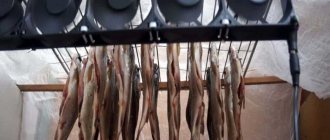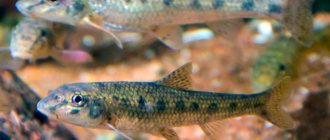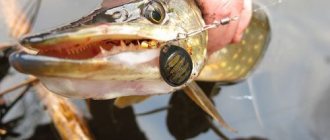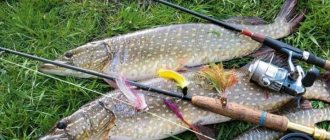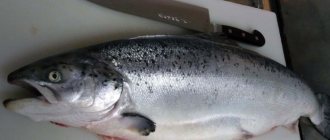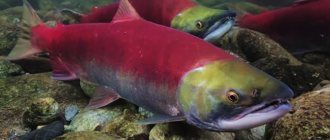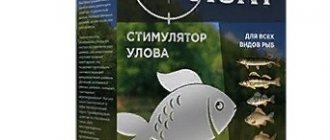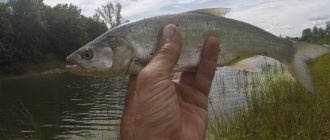Not every fishing trip brings a good catch. Weather changes, sudden changes in wind direction, incorrectly selected fishing location, off-season - all this can lead to a lack of fish in the cage. This is a bleak prospect for fishermen.
Perhaps you should pay attention to fishing flavors? But how effective are they? Every experienced fisherman will say: “Effective!” They can treat any bait: plant, live, artificial, or add it to all bait mixtures, thereby increasing their effectiveness: each particle is saturated with an attractive aroma, which lasts in the water for a very long time.
Ichthyologists divide the sense organs of fish into gustatory and olfactory. Unlike humans, they sense only substances dissolved in water and react to their minimal concentrations. Hungry fish swim up to the smell of components added to the bait. Thanks to this, the fisherman lures prey to a convenient fishing spot. The prey begins to feed in the feeding area, swallows the bait and ends up on the hook. [contents]
Fish Attractors
Attractant substances are not food for fish, they are designed to attract it and whet its appetite. They are added in small doses to bait or used to process the bait directly. These are oriental spices, oils, seeds of umbrella plants, some of them are reflected in the table. Their main goal is to encourage fish to swim to the fishing spot from a long distance.
Table. Popular supplements to attract peaceful fish.
| Additive name | In what form is it used? | Adding to bait | What type of fish is it suitable for? |
| Garlic | Ground dried (infusion) | 2-5% | Bream, carp, (crucian carp) |
| Anise | Powder | 6-8% | Bream, carp, crucian carp, roach |
| Star anise fruit | Ground | 2-5% | Peaceful fish of all kinds |
| Cinnamon | Dried ground | 2-5% | Bream |
| Fennel | Oil | 2-5% | Bream |
| Carob fruit | Ground | 5-10% | Bream, roach |
| Turmeric roots and stems | Ground | 10-15% | Roach |
| Dill | Ground | 4-8% | Bream, tench, roach, crucian carp |
| Basil leaves and seeds | Finely ground | 5-7% | Bream |
| Vanilla | Sugar | 6% | Carp, bream, roach, ide |
The above additives can be mixed to enhance the effect and add versatility to the feeding mixture.
For example, when fishing for bream, cinnamon goes well with coriander, basil, and vanilla. Garlic - with star anise, anise, basil.
Some fragrances can be easily made with your own hands. For example, an infusion of fresh garlic is used for catching crucian carp: knead 2-3 cloves, pour a glass of hot water, and leave for 5-6 hours. The resulting volume is poured into water to mix 1.5-2 kg of bait.
Fruit attractants are widely used. They are presented in the form of clean scents: strawberry, plum, banana, peach; as well as their combinations, are used mainly in the summer.
Supplements for Carnivores
The most accessible and widely known means of influencing the olfactory receptors of predatory fish is familiar to spinning anglers who fish with foam rubber. If such bait is soaked in fresh fish blood, the chances of a bite increase significantly. But the effect of blood as a bite activator is short-lived and lasts only 5-6 minutes. According to reviews, the blood of a predator is much more effective than the blood of white fish. Foam rubber fish is the optimal bait when using blood and other liquid attractants.
Pike hunts by attacking its prey from behind cover; it does not have time to try the bait. This fish is careful and picky. It is not easy to interest her with a foreign aroma, so you should choose bait with an odor close to natural. So, the smell of blood suits her perfectly.
Pike perch is very active and rarely stands in one place. Its life activity begins at night. All this complicates the fisherman's hunt for it. Having set a goal, he will no longer back down. A properly selected additive with a clearly defined odor is the key to success when catching it.
For pike perch and pike, the main flavors are anise, herring, garlic, crayfish, and shrimp.
Attractants act effectively on catfish. Preferred odors are ox blood and chicken giblets. They are very unpleasant for humans, but this fish reacts actively to them. When catching catfish, the bait is treated with a compound with a pungent odor. Diffusers that smell like fish, crayfish, or shells work well.
The use of attractants when fishing with artificial baits
The use of attractants when fishing for pike perch, perch and pike with artificial bait using spinning rods
On the street, everything speaks of the imminent start of summer spinning fishing. In a few days, spring will come, the feeling of which is felt every day, more and more rivers are freed from ice, into which predators begin to enter along with peaceful fish. Fishermen have more and more questions about where to go, what kind of fish and what to catch.
Today I want to talk about substances that help increase the number of bites of predatory fish, about various aromatic additives - attractants. Everyone knows about the effect of these substances on white fish, and there is no need to dispute this. With predatory fish, everything happens the other way around. Fishermen have two opinions about them; some claim that they are of no use at all, and the fish do not react to the smell. Others, on the contrary, claim that they work, the predator is caught more actively, and they always use them. There are also the majority of fishermen who have nothing to do with these substances at all. Perhaps simply out of ignorance, perhaps due to one’s conservatism or for some other reason. Some of my friends don’t use it because, in their opinion, it’s not sporty - for example, just like taking a landing net with you when fishing, fishing with two baits and using attractants. One fisherman from this company once while fishing, sitting opposite me, lost a couple of decent pike perch for 3 kg, because it doesn’t hurt to take a prickly one with your bare hand, at the end of the fishing, left completely without fish, he said that it was in vain that he didn’t take the landing net today.
I have been using aromatic substances for many years and I can say with confidence how they have a positive effect on the bite of predatory fish.
I'll start with the most popular fish among spinners - pike. As you know, the main type of hunting for pike is ambush hunting. That is, the pike stands in some kind of shelter and waits for a fish to swim by. In this case, her charm works less, and her lateral line and vision are better. This is where there is a divergence in the opinion of fishermen that the predator does not react to odors. I agree with this, but only regarding pike. Having used attractants many times when fishing for pike, I did not notice any noticeable improvements that could be paid attention to. The pike simply does not have time to make out in ambush whether the fish has a smell or not. At the same time, the use of the blood of other fish or animals that has spread under water can detain the pike for a long time; in the area of its spill, the pike begins to walk around this area over and over again, trying to find a smelling object. In this case, the pike perceives the smell, but in an ambush, I repeat, it has no time for that. Those who fish with dead fish or live bait deliberately inflict several wounds on the fish so that the blood flowing from the wound spreads throughout the reservoir and attracts pike with its smell. But today we are considering the influence of odors on predators only when fishing with artificial bait, and we will not delve into the method of fishing with live bait.
Pike perch is a completely different matter. As you know, pike perch is a nocturnal predator, that is, it hunts at dusk and in complete darkness, during the day it dozes in the depths of the reservoir, which is why pike perch comes first when searching for fish - the lateral line and the influence of the sense of smell on various odors. In addition, pike perch is an active predator; it rarely lies in ambush; its main method of hunting is an active search, followed by pursuit and attack of the victim. Moreover, missing, the pike perch repeatedly tries to catch up and attack the fry. This is often visible when catching pike perch with a spinning rod; after the first blow, there is a second one (if the pike perch does not prick the hook), then a second, or even a third, it often happens that the pike perch simply follows the bait, waiting for a better position to attack. When hunting, pike perch moves a lot around the reservoir, covering a long distance. In complete darkness, he cannot help but pay attention to the attracted smell while searching. Having sensed the smell, the pike perch begins to move in its direction and may have time to catch up with your bait if you do not move it quickly. It should also be said that attractants are produced with different smells; several variants of attractants are produced for one fish. Here it is very important to guess what kind of attractant smell will affect pike perch at a given time of year.
I once purchased one attractant - “Flavor gel, arti color, for fish bait” for pike perch and began to try to catch it by applying it to a twister. There were no bites; on the contrary, I noticed that the bites stopped completely. This went on for two years and I really wanted to throw it away, but one day in late autumn I used it and caught several large pike perch. All the pike perch were sea pike perch, that is, those that came from the sea, but there was not a single one of ours. As I later guessed, the smell of this aromatic substance was the smell of shrimp, and our jellied pike perch is not familiar with this smell. He did not pay attention to him and, on the contrary, treated him with distrust. At the same time, the sea pike perch, feeding on shrimp, remembered this smell well and attacked the bait with pleasure. Today I use this attractant only when sea pike perch enter the bay. At the same time, the total number of bites decreases. But the specimens I come across are more respectable, and by the end of fishing, the weight of the fish I caught was always greater than that of my comrades who fished without attractants.
Perch is also not indifferent to attractants, however, it is not always easy with it. Here a lot depends on the time of year and the specific attractant used. Often attractants that work in the spring do not work at all in the summer and vice versa. Once, having fished at one point and having already finished fishing, I decided to take a ride on a motor boat along the islands and see what was happening in other places. It was the middle of summer, and by eleven o'clock the sun began to scorch strongly, and we had to stop fishing. Having approached one of my favorite places, I saw three boats with fishermen catching perch. I asked how things were going and received a non-comforting answer - in the morning I had a few bites, and only small ones, but now there are no bites.
Having anchored, I applied the concentrate to a black twister with a jig head weighing 4 grams, fishing line 0.14. I threw the bait towards the sea channel, so that it lay slightly above the top of the dump, waited until it was completely submerged and started retrieving from there. On the dump itself, in this place at the bottom, grass grows, and a school of perches often hides in it. At the end of the drive, in the immediate vicinity of the boat, when I had already relaxed, there was a blow of such force that the tip of my ultra-light spinning rod went under the water and, to avoid a fracture, I had to lower it almost to the handle into the water. The perch was not weak, and I had to let go of the line and start fishing for it. After some time, the perch was successfully hatched and turned out to be of decent weight, approximately 500-600 grams. Within half an hour I caught seventeen of these perches. Neighboring boats came closer and cast to almost the same point as me, but they didn’t get any bites, and I had to fish out each perch in a bitter fight on a thin line, and all this in front of the fishermen. All the perches were from 550 to 800 gr., in general, it’s a pleasure to eat such fish. The bites stopped unexpectedly, it’s unclear where the school went, perhaps it fell to the bottom of the sea channel, and there I can’t reach it with my light baits. After exchanging opinions with our neighbors, we came to the conclusion that it was the attractant that influenced the activity of the perch.
Among other predators, the attractant also has an effect on the eel, which I repeatedly caught while fishing with a spinning rod. I simply dragged the twister along the bottom, using the flavoring agent to catch eels. From the twister at the bottom, there was clearly a trail with a smell, along which the eel, as if on a road, followed the smell, found the nozzle and attacked. In these cases, the wiring was done very slowly with frequent stops and movement of the twister at the bottom; it was necessary to hook on the first blow.
Of the flavoring agents I use, the aromatic additive did not bring a noticeable increase in the number of bites for pike perch. Although at certain moments, perhaps in stable, calm weather, it will work, but today I have not noticed an increase in bites with it. Twisters with aromatic additives (white and brown), which I purchased based on a highly praised article in one well-known fishing magazine, did not bring more than one bite from pike perch in two seasons, even before spawning; there were no bites during strong feeding. They also did not live up to expectations, but on the contrary, led to a deterioration in the bite of the twister with fillers.
Just a month ago, a flavor from the “Flavor gel, arti color, for fish bait” series for pike perch appeared in our stores in the form of an ointment. I bought one jar with the scent of shrimp and several with the scent of smelt. I have already tried the latter while ice fishing for perch. The flavoring with the smell of smelt worked well; my friend Andrey Balyshev and I, who also used this attractant, caught 100 pieces between us. perch, while the results of other fishermen were much more modest. I also expect good results for pike perch, especially in spring and autumn, until ice forms. I will definitely inform you about the test results.
Good luck on your fishing trip.
V. Prokaev
Qualitative characteristics
Carp love an abundance of complementary foods and a choice of bait. Females are especially picky; they very carefully approach the food; upon noticing the slightest threat, they retire to rookeries at the bottom of pits - favorite places of peace and relaxation. When purchasing, you need to take into account the compatibility of the components of the bait with the attractant.
Their correct combination is a guarantee of a good catch of a weighty trophy. Activators consist of synthesized pheromones, additives of animal and plant origin. In practice, choosing the right one is not an easy task. There are a huge number of their varieties and manufacturers on the modern market. Many fishermen make similar compositions at home.
Both factory-made and home-made mixtures must have some important characteristics that indicate their quality:
- Action area. The bait should attract fish from afar.
Versatility. The same attractant is effectively used to activate the bite of both predators: pike, pike perch, catfish, and white fish - carp, bream, crucian carp.- Effect on appetite. The bait should not only attract prey, but also increase its appetite. A fish that wants to eat loses its caution. She will greedily swallow the bait.
- Practicality. The supplement should be designed for several fishing trips and have convenient packaging.
- Ready to use. The ability to use bait immediately after adding an attractant is convenient for the fisherman.
- Environmentally friendly product.
The active substance in the mixture must be safe and not have a negative effect on the reservoir and its fauna.
Varieties
Attractants to enhance the carp bite are divided into groups depending on the fishing location, the presence of a current, and the type of bait. They are produced in the following forms:
Powders. Does not contain aromatic oils, but only natural ingredients in certain doses. Packaged in bags of different weights. It is used both in current and in still water. Added to the main bait. Main components:
- maggot;
- mayfly butterfly larvae;
- a red or green worm is special;
- mud, river grasses;
- hemp, rapeseed, flaxseed cake;
- bran.
bloodworm;
This attractant can be added to the bait or coated with it before casting.
Pills. Available in packs of 500 and 1 thousand pieces. They are easy to use: throw 8-10 pieces into the fishing spot. Once they reach the bottom, they begin to dissolve, forming a cloud that spreads over a wide area and lures the victim. The disadvantage is that the effect of one portion is designed for one hour, then you need to repeat the cast again.
They have the widest range of aromas: vanilla, cinnamon, dill, anise, tutti-frutti, barberry and others.
Among the taste preferences of carp, it is worth noting: honey, caramel, hemp, garlic, fruit aromas.
Carp baits can be divided into two types:
Sweet compounds. They are recommended to be mixed with activators based on essential oils and fruit or sweet products: halva, cookies, etc.- Spicy compounds. They need to be enhanced with the smell of dill, sunflower, and cake. In the cold season, aromas of animal origin are effective: shells, cod liver, crab attractants. You can use fishmeal, canned food, and boiled shrimp. Use them separately or complement them with the smell of garlic or hemp.
In spring and summer, fish prefer fruity and sweet aromas. During the cold period - smells of animal origin - canned fish, fish oil, blood, poultry offal and spices.
How did the homemade predator flavor “Perch Killer” come about?
I began to pay attention to the wrapping of bags of “edible” rubber and eagerly read through them in search of something familiar.
But I didn’t see anything there except hieroglyphs. Then I turned my attention to the purchased baits themselves. Touched it, smelled it, tasted it.
The silicones turned out to be salty - here's the first ingredient - salt. And there really isn’t enough salt in fresh water. All animals love salt. And to predatory fish, the taste of salt also resembles blood (aka salty).
Rubber baits feel somewhat greasy to the touch, which means they are soaked or lubricated with some kind of greasy substance.
The first thought prompted the use of some oils - sunflower, flaxseed, vegetable. But these aromas are more suitable for white peaceful fish.
And then I remembered about fish oil. Here is the second ingredient for a homemade flavoring for predatory fish. You can use fishmeal instead of fish oil.
And so that the most aromatic solution (attractant) is always enough, so that it does not quickly evaporate and sticks perfectly to the bait, I added pharmaceutical Vaseline.
Instead of Vaseline (since it “dumbs” in the cold), you can take lard and melt it.
Fishing sauces
Dips are a type of attractant. The name comes from the English word “dip”, which means dipping, immersion. They are impregnating liquids containing amino acids, sugar, and flavorings. They come in liquid, powder, and gel forms. The bait is dipped into them before casting, after which it is saturated with aroma and other properties attractive to fish.
These supplements are now produced by hundreds of manufacturers. Despite all the diversity, they are divided into two groups:
- Simple - capable of luring fish. They were originally used for catching bream, crucian carp, and other types of fish. They are oil-based liquids mixed with aromatic substances. They are simple and convenient, good for short fishing, and nowadays they are successfully used by fishermen. The bait is dipped into the odorous solution for a few seconds and is ready to be cast.
Simple ones include sticky dips. They are a sticky aromatic gel. The bait immersed in it is covered with a shell, which dissolves in water and attracts fish. Before use, place the jar in hot water. When heated, its contents become more liquid. The bait is dipped into it, then it cools in the air, turning into a gel again. Corn grains, pellets, and other bait particles can easily be glued to a still warm boilie treated with such an attractant.
- Nutrients - lure fish and stimulate their appetite. They differ from simple ones in their manufacturing recipe and method of application. The bait is immersed in them for a long time. They are more stable and effective: they better transmit food signals to prey, and have a longer and more complex effect on the fish.
Luminous dips are nutritious; their composition contains a gel that can glow in water. Its greenish glow is the main attraction for fish. This type of bite activator is divided into two types: for daytime fishing and night fishing. The latter has the function of charging from the light of a flashlight.
The fish sees the ultraviolet glow of the bait. Adding sparkles to the substance gives a good attractive effect. Suitable materials for using illuminated lubricants are ribbed silicone and foam rubber.
Many carp anglers prefer powder additives. When using them, the bait is dipped into water, then into powder and back into water. During these manipulations, the boilie is covered with a layer of jelly, which, dissolving in water for several hours, transmits appetizing and luring signals to the fish.
This type of nutritional fluid has many beneficial properties. Some are used as preservatives: boilies soaked in them remain fresh for several weeks even in hot weather. Other dips keep pre-dried baits moist for up to several months. Fishermen carry them with them, using them for a long time if necessary. They are also used to increase the efficiency of artificial baits.
You can buy them at any fishing department or make them yourself. The basis is taken of several nutritious liquids, different in properties, to which one or more other components are added: flavors, essential oils, powder components.
TOP 5 attractants for catching predators
The modern fishing industry offers not only a wide selection of artificial baits, but also additional devices that improve the bite. These methods include applying a specialized gel, paste or liquid to the bait. The attractant gives the bait taste and a strong smell. During the period of passive biting, when the fish is in no hurry to swallow the prey, the taste enhancer affects the receptors of the predator, and it takes the bait more greedily.
Many anglers are equipped with several types of attractants with different tastes. Oddly enough, when catching a predator, meat aromas do not always win out, bringing plant aromas to the fore. Thus, anise oil is considered one of the working options.
What do you need to know about the attractant?
When using such a product, a fragrant cloud is created around the nozzle, which arouses the interest of pike perch, pike and other predators. With the help of attractants, you can distinguish a specific bait from the bait. Such products are sold in different forms, and they contain not only amino acids and sweeteners , but also flavorings. In most cases, these are extracts from plants, as well as substances of animal origin that are rich in hormones. Naturally, companies producing such attractants do not reveal their preparation secrets.
With proper use of good flavors, the bait will become really effective when fishing for pike and other fish. Some anglers prefer to use dyes, which helps create a cloudy cloud in the water and give the bait a certain tint. However, such products are inferior to attractants, which have their own distinct taste and attractive smell.
Unlike conventional flavorings, attractants contain amino acids, the presence of which is felt by pike perch, pike and other fish. These substances affect the taste buds, awakening the predator’s appetite, due to which the fish not only approaches the bait, but also decides to bite.
Unlike conventional flavorings, attractants contain amino acids, the presence of which is felt by pike perch, pike and other fish. These substances affect the taste buds, awakening the predator’s appetite, due to which the fish not only approaches the bait, but also decides to bite.
We prepare attractants with our own hands
Let's start, perhaps, with the simplest thing - with flavors. For 1 liter of water you will need 4 tablespoons of baking flavor. Stir well, put on low heat and wait for it to boil. Wait another 15 minutes, and then safely turn off the stove. The flavored additive that can be added to the bait is ready.
Bait with a pronounced garlic smell is prepared as follows. Pass 4-5 cloves of garlic through a garlic press. Mix with 2 tsp. any oil. Stir and let stand for 30-40 minutes.
When choosing an attractant, you need to consider who it is intended for. Fish have different tastes, which means they will have to be lured in different ways.
Let's prepare bait for crucian carp . Pour boiling water over a handful of pearl barley and wrap it up. Wait until the cereal swells. This usually takes 3 hours. Then add one of the following: cocoa, garlic, crushed dill seeds, anise, vanillin.

